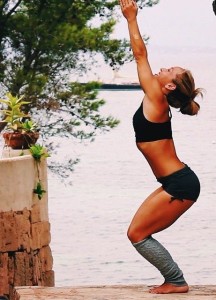operating instructions….6-2-15

Back in the day, I taught a mat class in the clinic called Loosen, Lengthen, Strengthen. When the opportunity arose to collaborate for a six week series focused on strength at It’s All Yoga, I perked right up.
Power Up! ( https://clients.mindbodyonline.com/classic/home?studioid=4333) begins today: Tues/Thurs 12:00-12:45 six week series. You can drop in anytime and check out this high energy opportunity for “personal training” without strain. No mirrors, no meatheads. This is territory I know and love and have a pretty unique spin on.
So the recent newsletter from Michelle Marlahan, owner of It’s All Yoga (http://www.itsallyoga.com/), about being appalled at advice given by a fitness M.D. hit a deep nerve. Pointers on “braced neutral standing posture” to protect your spine in daily living were boiled down to this list, verbatim:
- Squeeze your butt as hard as you can.
- Pull your ribcage down.
- Get your belly tight.
- Set your head in a neutral position and screw your shoulders into a stable position.
I was as appalled as Michelle. This is no way to live a fluid and relaxed life. And yet there are times we go to the gym or power train or just lift that 90 pound bag of dog food when intelligent bracing is called for. So I decided to write my own list of four, called operating instructions: what to pay attention to in those training AND everyday moments when being careful is called for.
- Take a body side view: feel the line that drops through earlobe, shoulder, hip and ankle. The gentle neck curve and low back sway fall in front of that line. The back curve of ribs and hook of tail lay behind. These curves are needed! This is neutral alignment, the safest and most efficient base for arms and legs to lift from.
- Take a body front view: notice that face, shoulders, hip points and feet are pointed in the same direction. Unless you are intentionally training in a diagonal plane (a bit trickier!) this orientation provides maximum safety and efficiency when legs and arms are lifting or carrying a load. Even your body weight can be a load when training in repetitive activities, like squats and lunges, curls and presses. Combine twisting and lifting with extreme caution.
- Feel your breath: tune in to the natural way to marry breath and motion. We are built to exhale during heavy exertion, like exhaling up from a squat or breathing out while curling a weight to shoulder. Seek and engage the natural breath and motion pattern. Notice where and when the habitual tendency to breath hold appears and quit that. BREATHE!
- Feel your deep power: feel what the body already does naturally with each breath cycle. 1) Exhale and gently draw pelvic floor up and deep abdominals back. Key word is GENTLE. 2) Inhale and tenderly lift breastbone as shoulder blades glide down and back of neck lengthens. Key word is TENDER. Harness this natural occurrence effortlessly by focusing attention on the marriage of breath, motion and power. This is a 25% muscular contraction, no gripping, squeezing or pulling allowed. This activation does not change the side view curves or the front view orientation.
Besides feeling so darn good, strength training is such an effective way to improve bone density and core stability. And daily life requires strength sometimes. Think gardening, cleaning the garage, lifting groceries from the trunk, caring for infants and elders. The list is long and includes all the ways we often sustain injury. This “braced” advice can truly be useful. Gently practicing these four operating instructions—integrating alignment, breath, power and motion— creates a field of safety, effectiveness and mindfulness.
Wanna learn some more? Come down some Tuesday or Thursday around lunchtime.